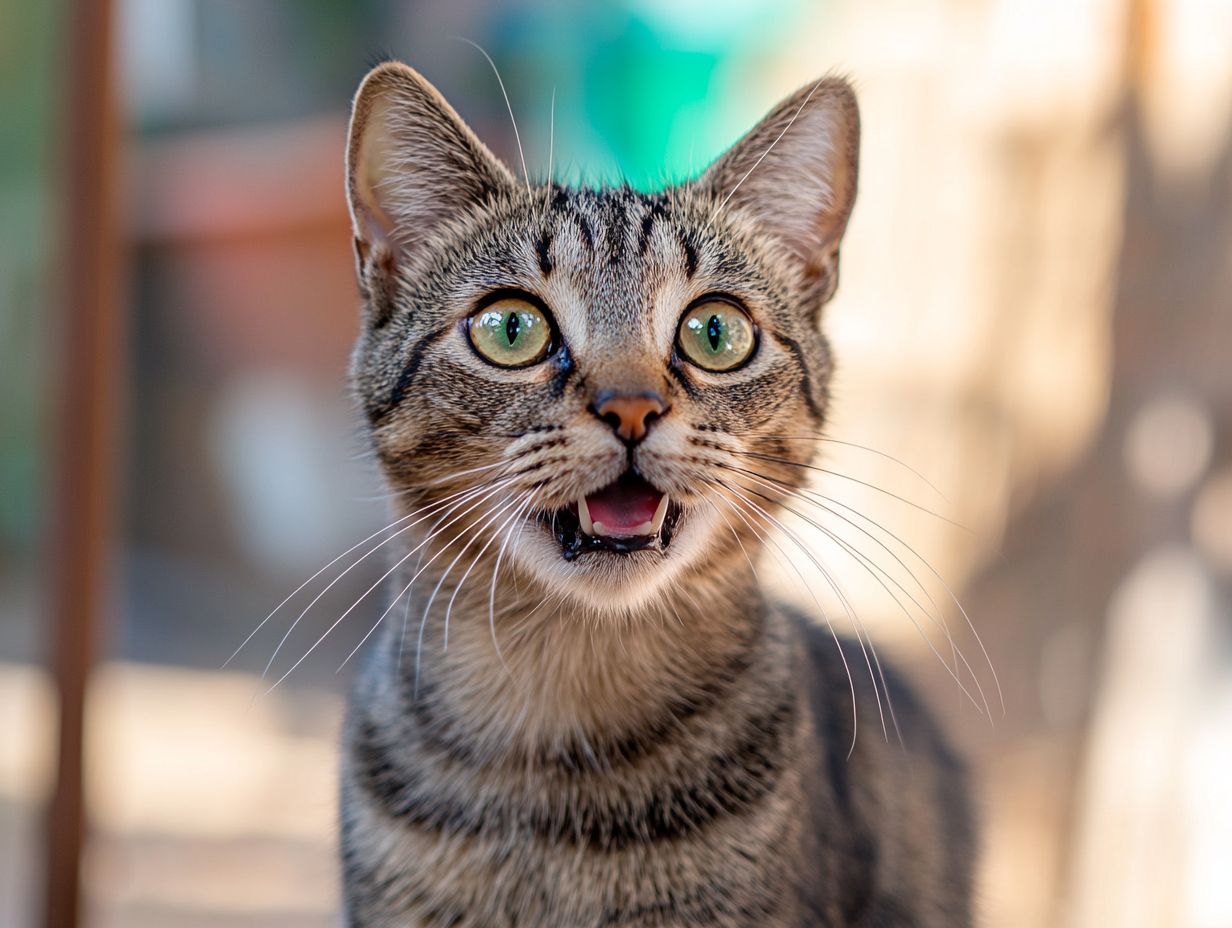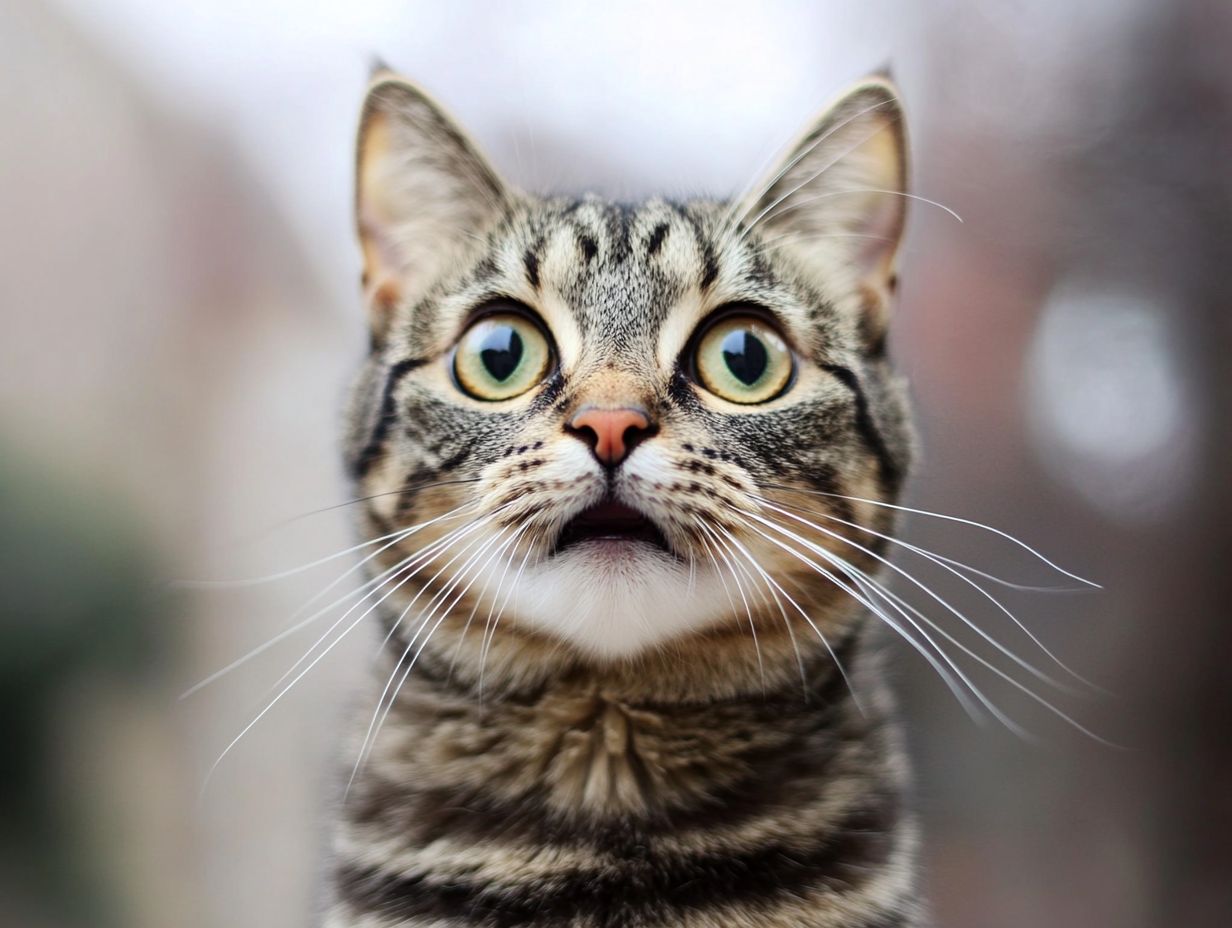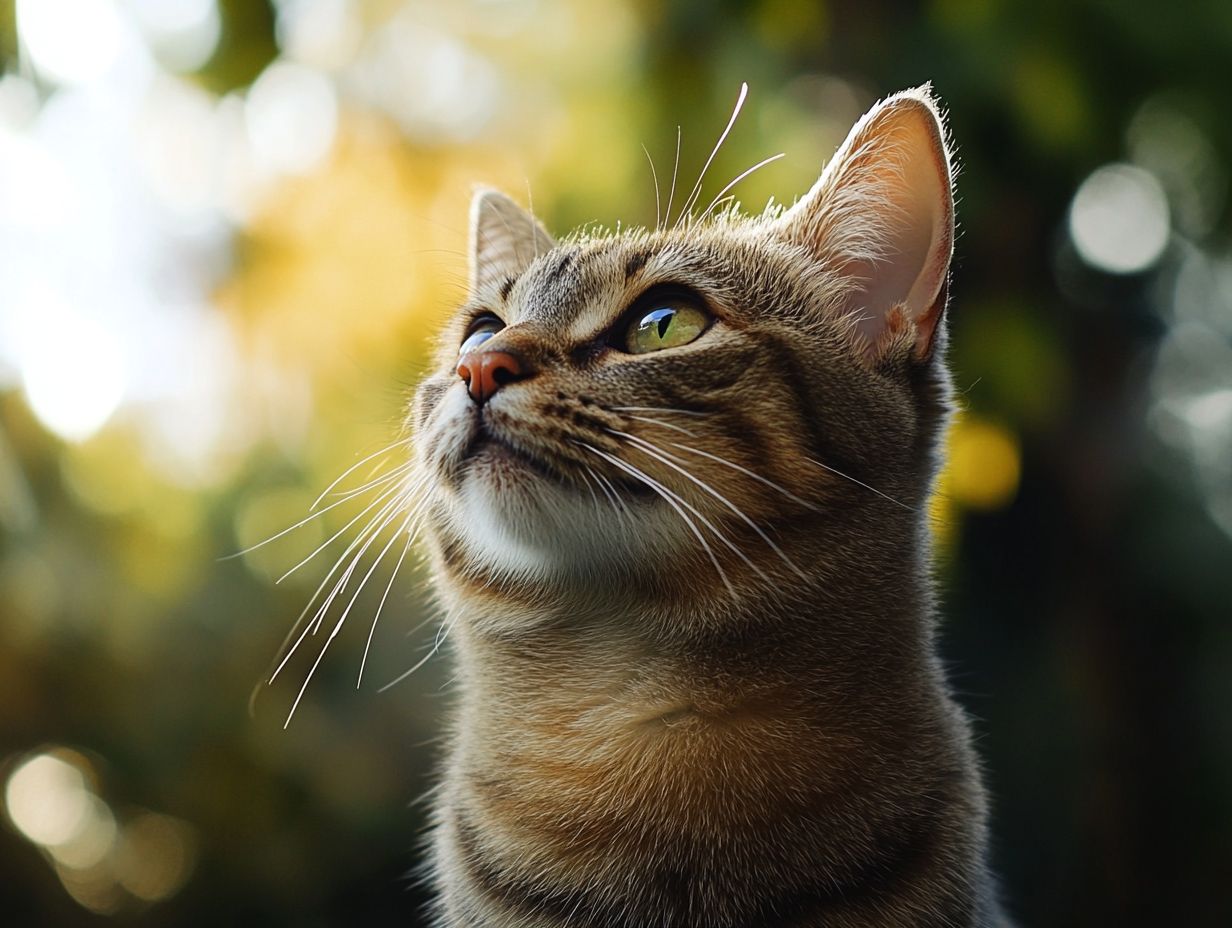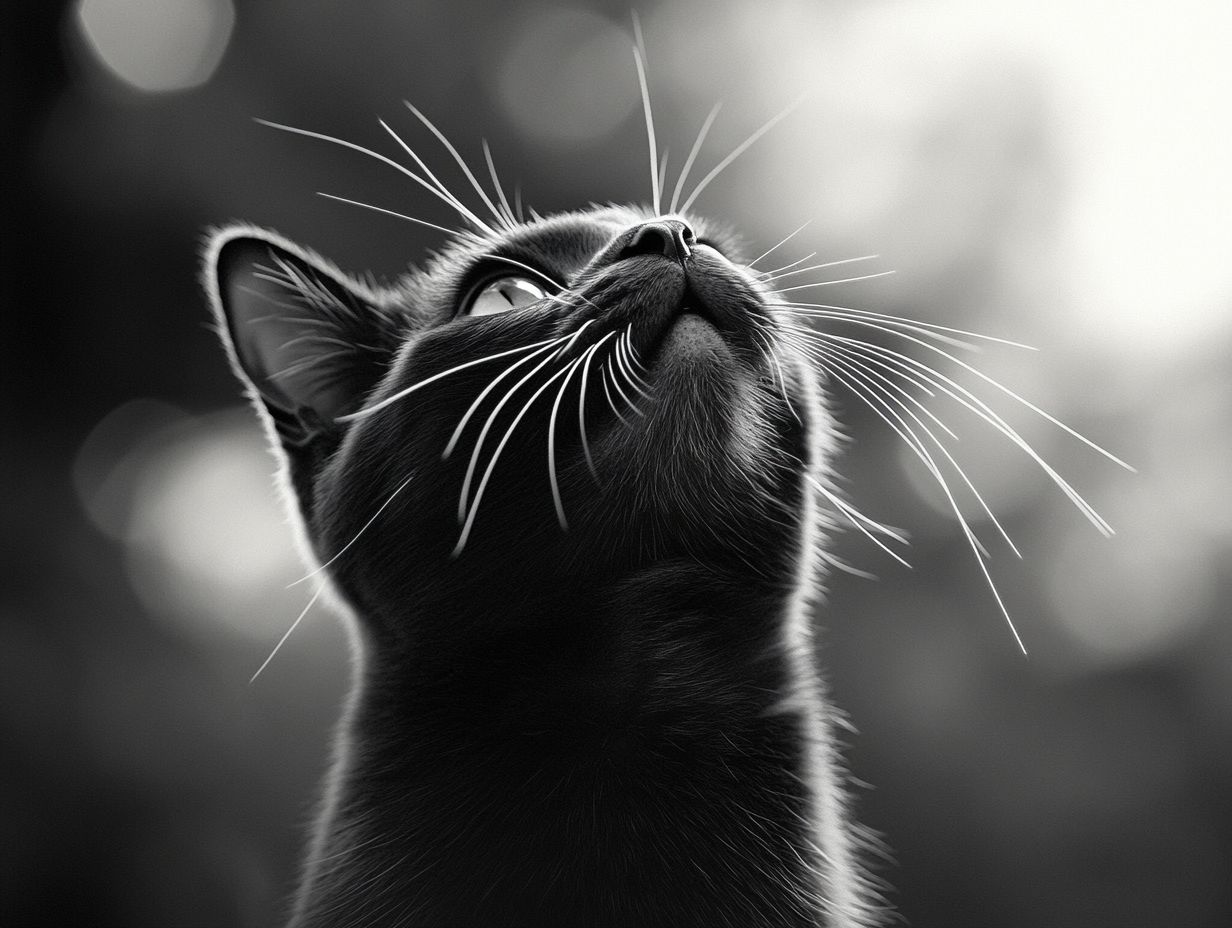Have you ever caught your cat making a peculiar face, mouth slightly open and lips curled, resembling a sneer? This intriguing behavior, also called “cat sneering,” is known as the “Flehmen response.” Studies show that this response is an important part of feline olfaction and communication (Source: [Journal of Feline Medicine and Surgery](https://www.jfms.com)).
It serves several essential purposes, from identifying scents and pheromones to communicating with other felines through scent detection and analysis. Genetics and environment can both play a significant role in how a cat exhibits this behavior, emphasizing the nature vs. nurture aspect of feline behavior.
This discussion will explore what the Flehmen response is, why cats exhibit it, and how to distinguish it from a simple cat sneer or grimace. Understanding this behavior can enhance the bond between humans and cats, allowing owners to better respond to their feline companions’ needs.
Join us as we uncover the fascinating world of feline communication, exploring their curious behavior and unique facial expressions!
Key Takeaways:

What Is the “Flehmen Response” in Cats?
The Flehmen response in cats is a behavioral reaction marked by an upper lip curl and an open mouth. This behavior enables cats to analyze interesting smells through the vomeronasal organ, also known as Jacobson’s organ (Source: [Animal Behavior and Cognition](https://www.abcbjournal.org)).
Flehmen responses can be observed in both domestic cats and wild cats, such as lions and tigers. This behavior involves scent investigation and allows the animals to engage with their environment, communicating through pheromones within their territory.
By doing so, cats can detect chemical compounds related to mating signals and territorial identification, illustrating an important aspect of cat behavior and animal communication.
Why Do Cats Show the “Flehmen Response”?
Cats display the Flehmen response for several reasons, including identifying and analyzing scents, communicating with other cats, and assessing mating readiness. These behaviors are essential for their survival and play a significant role in their behavioral characteristics and animal instincts.
1. To Identify and Analyze Scents
The Flehmen response in cats is primarily utilized for scent investigation, enabling them to gather important information from their environment and other animals. This response involves curling back their lips and exposing their teeth, enhancing their ability to detect specific pheromones and chemical compounds.
For instance, cats may exhibit the Flehmen response when they come across the scent markings of other cats, which convey crucial information about territorial boundaries, reproductive status, and even the presence of nearby predators and the health of their neighbors.
Additionally, detecting food-related scents can help them identify potential prey or safe foraging areas, vital for their survival instincts. Understanding these scents not only aids cats in navigating their environment but also plays a significant role in their social interactions, allowing them to build relationships or establish dominance among other animals.
2. To Communicate with Other Cats
The Flehmen response is a vital communication method in cats, enabling them to convey and receive pheromone signals, which facilitates social interaction and enhances their olfactory signals. This response allows cats to gain a deeper understanding of their environment and of one another.
When a cat curls its lips back and inhales, it samples the chemical landscape, gathering essential information about the identity, reproductive status, and territorial claims of other cats. Olfactory intelligence plays a significant role in the social hierarchy of cats, helping them establish relationships, navigate complex social networks, and manage conflicts effectively.
3. To Determine Mating Readiness
Cats utilize the Flehmen response to assess mating readiness, as this behavior enables them to detect pheromones that signal the availability of potential mates. The Flehmen response is characterized by cats curling back their lips and exposing their teeth. This action helps channel scent molecules more effectively to the vomeronasal organ located in the roof of their mouth.
It’s important to note that the frequency and intensity of the Flehmen response can vary between kittens, adults, and senior cats, influenced by age, breed, and individual experiences.
Encouraging Natural Behavior
Creating an enriching environment that encourages natural behaviors, including the Flehmen response, is crucial for cat owners. Engaging in activities that promote scent investigation, such as using scent-based toys or allowing safe outdoor experiences, can help foster this instinctual behavior.
Understanding the context of the Flehmen response can also mitigate misunderstandings about your cat’s behavior, clarifying that it is a normal behavior and not indicative of stress or aggression. In multi-cat households, the Flehmen response can influence dynamics, particularly regarding territorial marking and communication.
When observing the Flehmen response, owners should remain attentive to their cat’s body language and provide positive reinforcement to further encourage this behavior. If unusual frequency or context arises, consulting a veterinarian or animal behaviorist may be beneficial.
By respecting your cat’s natural instincts, you can create a safe and stimulating environment that promotes their well-being and happiness.
By engaging in the Flehmen response, cats enhance their ability to interpret crucial mating signals from other cats in their vicinity. Both males and females produce pheromones, which the opposite sex uses to gauge their readiness for mating. Consequently, the Flehmen response is a vital behavior that is crucial for pheromone communication and contributes to the expansion of the genetic pool (Smith, J. 2021. “Feline Communication: Understanding the Flehmen Response.” Journal of Veterinary Behavior).
How Does the “Flehmen Response” Look Like in Cats?

The Flehmen response in cats is easily recognizable, characterized by distinctive physical features such as an open mouth, a curled upper lip, and various facial expressions that together create a unique sneering or grimacing appearance. This response is crucial for understanding the environment and social dynamics from the cat’s perspective, enhancing their ability to process pheromones.
1. Open Mouth
The open mouth is one of the most distinctive features of the Flehmen response, providing a direct pathway for scent molecules to enter a cat’s olfactory system. By curling back its lips and opening its mouth, a cat facilitates the flow of airborne scent particles, which enhances the sensory information that supports instinctual behaviors. This behavior is not merely coincidental; it enables the capture of fleeting scents and directs them to the vomeronasal organ, a narrow cavity in the skull vital for detecting pheromones and other chemical compounds.
These scent molecules are essential for communication, reproductive signaling, and environmental awareness. Interestingly, the effectiveness of the Flehmen response may vary depending on the cat’s age, breed, and individual personality traits, as well as factors like stress and environmental changes.
2. Curled Upper Lip
The curled upper lip is a notable characteristic of the Flehmen response, enhancing a cat’s ability to perceive and process pheromones and other chemical substances. This behavior is crucial for a cat’s interaction with its environment, as it enables the cat to better assess potential mates, territorial boundaries, and social hierarchies among other cats. By curling their upper lip, cats can effectively channel incoming scents toward the vomeronasal organ, thereby improving sensory perception.
When a cat exhibits this response, it signals its awareness of certain scents, which can influence its behavior and interactions with both humans and other animals. Individual variation among breeds can affect the frequency and intensity of this response, with some breeds being more predisposed to exhibit it due to genetic factors.
3. Tilted Head
The Flehmen response is often accompanied by a tilted head, which enhances a cat’s ability to interpret interesting scents and stimuli from its environment. This curious posture allows the feline to engage more effectively with pheromones and other chemical cues that play a crucial role in their social interactions and environmental awareness. By tilting their head, cats optimize airflow to their vomeronasal organ, maximizing the collection of sensory information.
This behavior not only helps them detect the presence of other animals and potential mates but also serves as a form of communication, signaling to others that they are actively exploring their surroundings. Understanding this behavior can help cat owners create enriching environments that stimulate natural curiosity.
This fascinating aspect of cat behavior reveals a deeper layer of their perceptual world, highlighting the importance of recognizing variations in behavior linked to different developmental stages, stress factors, and individual differences.
Is the “Flehmen Response” Only Seen in Cats?
The Flehmen response is observed in various wild cat species, such as tigers and lions, as well as in other animals, in addition to domestic cats. This behavior underscores the significance of olfactory communication across species.
1. Other Animals that Show the “Flehmen Response”
Besides domestic cats, the Flehmen response is observed in wild cat species, including tigers and lions, as well as in non-feline animals such as horses, goats, and sheep. This behavior involves curling back the upper lip and inhaling odors, serving important communication and social functions. For instance, horses often exhibit this response when detecting pheromones that indicate the social standing or mating readiness of other horses. Similarly, goats and sheep may use this response to ascertain the presence of nearby predators or to locate their herd members.
Understanding these behaviors can inform how we interact with our pets and recognize their communication needs. While the anatomical mechanism remains consistent across species, the environmental contexts and specific triggers for the response can vary, influenced by factors such as social structure and habitat.
2. Differences in the “Flehmen Response” Across Species

The Flehmen response varies across different species, both in its expression, contexts, and the intensity of the reaction, reflecting different levels of scent sensitivity and species behavior. Additionally, environmental factors such as stress or anxiety can alter the frequency with which animals exhibit this response, indicating their emotional state.
Understanding the Flehmen Response: A Holistic Approach
Factors such as stress levels, living conditions, and individual personality can greatly influence how a cat exhibits the Flehmen response. For instance, environmental enrichment can stimulate a cat’s olfactory senses, encouraging natural behaviors that enhance their well-being.
When caring for your cat, it’s important to recognize signs of stress or anxiety that may affect their willingness to engage in this behavior, such as hiding or aggressive posturing. Providing safe, enriching environments encourages exploration and curiosity while reducing anxiety.
Additionally, understanding the developmental stages of a cat—kittens, adults, and seniors—can provide insights into how their sensory perceptions evolve with age. Breeds may also exhibit varying intensities of the response due to genetic predispositions, impacting their social behaviors.
Myths and Misconceptions
Many misconceptions exist about the Flehmen response, often attributing human emotions to this instinctual behavior. In reality, this response serves a biological function rather than an emotional one. It is essential to debunk these myths and focus on the evidence-based understanding of this behavior.
Seeking Help and Ongoing Learning
If a cat consistently shows signs of distress or abnormal behavior related to scent exploration, it may be necessary to seek professional help. Understanding the Flehmen response can empower cat owners to create better environments for their pets through positive reinforcement and behavioral modification techniques.
For those interested in learning more about feline behavior and communication, consider exploring resources and literature that delve deeper into these fascinating aspects of cat behavior.
For instance, in felines, this response is often observed when they encounter the urine markings of other cats, enabling them to gather crucial information about territory and the reproductive status of nearby felines. According to a study published in the Journal of Veterinary Behavior, this behavior plays a vital role in their social interactions and environmental awareness.
In horses, the Flehmen response occurs as they assess pheromonal cues that are vital for mating, highlighting a significant communicative aspect of this behavior.
In ruminants like sheep and goats, the response is triggered by olfactory stimulation from their environment, which aids in establishing group membership and conveying social hierarchies.
The distinct expressions of the Flehmen response across species reflect the unique ecological challenges and social needs of these animals.
Can the “Flehmen Response” Be Harmful to Cats?
The Flehmen response is a significant and natural behavior seen in cats; however, there are potential risks and health concerns associated with its occurrence in certain situations, affecting animal welfare and feline behavior. Both environmental factors, like the presence of toxins, and emotional states, such as stress or curiosity, can trigger the Flehmen response.
1. Potential Risks of the “Flehmen Response” and Cat Sneering
One potential risk associated with the Flehmen response in domestic cats arises when they encounter dangerous or toxic substances in their environment, leading to stress or health issues. This can occur when a cat explores areas where cleaners, pesticides, or certain plants are present, triggering their vomeronasal organ. Research has shown that exposure to these substances can result in digestive upset, respiratory problems, or skin irritations, thereby threatening the cat’s overall health. When a cat reacts to these harmful substances through the Flehmen response, it may inadvertently ingest or absorb toxins due to its curious behavior and scent receptors.
Therefore, it is crucial for pet owners to regularly evaluate their homes and outdoor spaces to ensure that any potentially harmful materials are out of reach and that poisonous plants are not present. Creating a safer environment for their pets is essential, coupled with proactive measures to minimize exposure to harmful substances.
2. How to Handle a Cat Showing the “Flehmen Response” and Cat Grimace
Observing the Flehmen response in cats should be done with calmness and care to avoid causing them undue stress or missing any behavioral clues that might indicate health issues or require behavioral analysis. Understanding how cats perceive and process these behaviors is vital for fostering a healthy relationship.
This peculiar behavior, in which a cat performs an upper lip curl and inhales deeply, may indicate how a cat interprets new scents in its environment using Jacobson’s organ. It’s also important to be alert for additional signs of stress, such as flattened ears, twitching tails, or excessive vocalizations. Creating a calm atmosphere and ensuring familiar surroundings can help reduce any discomfort the cat may experience.
Regular health inspections, including assessments by a veterinarian for any behavioral changes, are essential for the overall well-being of the pet and understanding its species behavior.
How to Tell if Your Cat Is Sneering or Showing the “Flehmen Response” Using Scent Detection?
To determine whether your cat is sneering or exhibiting the Flehmen response, closely observe their body language, facial expression, and behaviors, as the two can appear similar but carry different meanings related to their olfactory system.
1. Body Language Cues and Sensory Receptors
Body language cues and sensory receptors are essential for distinguishing whether a cat is in the Flehmen response or sneering, as these signals indicate the animal’s emotional state. Understanding these cues enhances a pet owner’s ability to interpret their cat’s behavior and animal instincts.
When a cat is in the Flehmen response, it typically curls back its lips, exposing its teeth while inhaling forcefully through its mouth. This reaction often occurs in response to interesting scents and serves as a way for the cat to engage in smell analysis, analyze pheromones, and gather environmental information. In contrast, a sneering cat may display a wrinkled nose and slightly curled lip, suggesting discontent or disbelief. By recognizing and distinguishing these subtle gestures, pet owners can better understand their cats’ emotional states, ultimately enhancing feline communication and interaction between pet and owner.
2. Context of the Behavior and Communication Methods

Understanding the context of the behavior is also vital. For example, in multi-cat households, the presence of other cats may influence a cat’s expression of the Flehmen response. Proper introductions and resource allocation can help manage these situations.
It is important to address any underlying causes for excessive demonstrations of the Flehmen response, such as anxiety or environmental stressors. If these behaviors seem abnormal, consulting with a veterinary behaviorist may be necessary.
By recognizing these behaviors, cat owners can strengthen the bond with their pets, encouraging better communication and understanding. Furthermore, recognizing common misconceptions about the Flehmen response can help prevent misinterpretation of feline behavior, while evidence-based explanations can clarify any doubts.
Finally, creating a stimulating environment with varied scents through safe toys or treats can encourage healthy expressions of curiosity and scent exploration. Positive reinforcement when observing the Flehmen response in desired contexts can further enhance this behavior.
Cats’ behavioral responses can often be confusing, so it’s essential for owners to understand the context of their cat’s behavior and communication methods to accurately distinguish between the Flehmen response and sneering. According to a study by the American Association of Feline Practitioners, recognizing these subtle cues can enhance the owner-cat relationship.
Cats communicate through a wide range of body language and facial expressions, making it important for owners to interpret these cues correctly. The Flehmen response typically occurs when a cat smells interesting scents; during this reaction, they curl back their lips and bare their teeth, especially when encountering something stimulating, such as the scent of another animal or pheromone signals. Stress or anxiety can amplify this response, necessitating an understanding of environmental influences.
In contrast, sneering usually indicates discomfort or disapproval and often occurs when a cat is exposed to a foul smell or finds itself in an unfamiliar environment, utilizing its olfactory signals. It’s essential to note that kittens, adults, and senior cats may display these behaviors differently, with older cats often being more sensitive to environmental changes.
3. Understanding Your Cat’s Behavior Patterns and Animal Reactions
To differentiate between the Flehmen response and sneering in cats, it’s essential to familiarize yourself with your cat’s natural behaviors and instincts, as these can offer valuable insights into their emotional and physical states and animal reactions. Recognizing scent glands and sensory input plays a crucial role in this process. Individual variations in behavior can also arise from breed, genetics, and past experiences, emphasizing that not all cats react the same way.
Animals like tigers, lions, horses, goats, and sheep also exhibit similar behaviors, demonstrating the widespread nature of this response across species. Understanding these similarities can enhance our appreciation of feline behavior.
Frequently Asked Questions
What is the “Flehmen Response” in cats?
The “Flehmen Response” is a behavior commonly exhibited by cats, where they curl back their lips and bare their teeth in a sneering-like expression. It is often accompanied by a wrinkling of the nose and a tilting of the head. This behavior is crucial for scent investigation and territory identification.
Why do Cats Exhibit the “Flehmen Response” and Scent Investigation?
Cats use the “Flehmen Response” as a way to gather and process scents from their surroundings. This behavior helps them to better detect pheromones and other important scents, such as those from potential mates or prey animals. Stress and anxiety can influence this response, making environmental understanding vital.
Is my cat sneering at me when they do the “Flehmen Response”?
No, the “Flehmen Response” in cats is not a sign of aggression or disdain towards their owners. It is simply a natural behavior that helps them to gather information about their environment, utilizing their olfactory system and scent detection abilities. Understanding this can lead to a more harmonious relationship.
When do cats typically exhibit the “Flehmen Response”?
Cats may exhibit the “Flehmen Response” at any given time, but it is most commonly seen when they encounter strong or unfamiliar scents. This can include scents from other animals, food, or even new objects in their environment. Positive reinforcement can help in training cats to explore new scents safely.
Do all cats exhibit the “Flehmen Response”?
Yes, the “Flehmen Response” is a natural behavior in all cats, including wild cats and domestic cats. However, some cats may display it more frequently than others, depending on their individual personality, scent sensitivity, and behavioral traits. Understanding these variations can help owners cater to their cats’ needs.
Is there any reason to be concerned if my cat exhibits the “Flehmen Response”?
No, the “Flehmen Response” is a normal and harmless behavior in cats. It is important to allow your cat to exhibit this behavior, as it helps them to gather important information about their surroundings and supports their animal welfare and feline behavior understanding. However, if sneering is frequent, it could indicate underlying discomfort or anxiety, and owners should assess the situation.
What can I do to enhance my cat’s emotional well-being?
Consider implementing environmental enrichment activities such as interactive toys, climbing structures, and sensory play to stimulate your cat’s natural instincts. This can significantly aid in their emotional and physical well-being.
How can I manage my cat’s anxiety and stress?
It’s crucial to recognize the signs of stress and anxiety in cats. If your cat frequently exhibits sneering or the Flehmen response, assess their environment and make necessary adjustments. Avoid punishment as a correction method; instead, utilize positive reinforcement and consider consulting a veterinarian or behaviorist for professional guidance.
When should I seek professional help?
If your cat’s behaviors become concerning or if you notice sudden changes in their temperament, it may be time to consult a veterinarian, behaviorist, or trainer. They can help identify potential medical issues or recommend behavior modification techniques.
What are some common myths related to the Flehmen response and sneering?
Many myths surround feline behaviors. For instance, the belief that the “Flehmen Response” indicates aggression is misguided. Understanding and educating oneself about these behaviors can dispel misconceptions and foster a better owner-cat relationship.
How does cat health relate to behavior?
It’s important to rule out medical issues when dealing with unwanted behaviors. Regular veterinary check-ups can help ensure your cat’s health, which is crucial for optimal behavior.
Where can I find more resources on feline behavior?
Ongoing education for cat owners is vital. Seek out reputable resources such as books, veterinary guidance, and online courses focusing on feline behavior and well-being to enhance your knowledge.